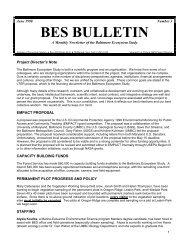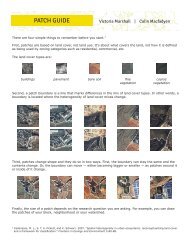Investigations in Urban Soils - Baltimore Ecosystem Study
Investigations in Urban Soils - Baltimore Ecosystem Study
Investigations in Urban Soils - Baltimore Ecosystem Study
You also want an ePaper? Increase the reach of your titles
YUMPU automatically turns print PDFs into web optimized ePapers that Google loves.
Draft 2 - (9.28.04)<br />
<strong>Soils</strong> <strong>Urban</strong> <strong>in</strong> <strong>Investigations</strong><br />
5. Practice the worm sampl<strong>in</strong>g procedure once yourself. Get <strong>in</strong>to the habit of<br />
count<strong>in</strong>g worms as you collect them. Always wear gloves when handl<strong>in</strong>g soil.<br />
6. Note: if your class decides to take on worm identification, prepare for two<br />
additional tasks: quick-ID, and worm fix<strong>in</strong>g. To quickly classify an earthworm as<br />
exotic or native, use the general tips <strong>in</strong> the Background for Teachers. The tips<br />
are not foolproof, nor are they without exception. Worm identification is very<br />
tricky! To fix worms, you will need ethanol and formal<strong>in</strong>, and the jars for storage.<br />
Procedure:<br />
1. Divide students <strong>in</strong>to teams of two or three. Provide maps of the <strong>in</strong>vestigation site<br />
and discuss what m<strong>in</strong>i-habitats with<strong>in</strong> the site might yield different numbers of<br />
earthworms. M<strong>in</strong>i-habitats might <strong>in</strong>clude leaf-covered, shady, garden, near<br />
bushes, etc. Teach students the term study plot to call the different habitats that<br />
teams will sample. Label and number study plots on a large version or overhead<br />
transparency of the map. If desired, use surveyors’ flags to mark the study plots<br />
at the <strong>in</strong>vestigation site. Assign teams to study plots.<br />
2. Make sure students understand why they will be sampl<strong>in</strong>g worms at different<br />
m<strong>in</strong>i-habitats on the site. This is a good time to review the <strong>in</strong>vestigation question:<br />
What effect does habitat have on earthworm population? Create a class list of<br />
habitat factors the students th<strong>in</strong>k might affect earthworm population. Create<br />
separate lists for factors that are observable and those that are measurable. Use<br />
the lists to create a data sheet for the <strong>in</strong>vestigation days. (Note: students may<br />
decide that the mass of worms is important to measure. Weigh<strong>in</strong>g worms<br />
requires add<strong>in</strong>g extra steps to the basic protocol that must also be demonstrated:<br />
blott<strong>in</strong>g the worms and weigh<strong>in</strong>g them either at the site or back <strong>in</strong> the classroom.)<br />
3. Provide copies of the earthworm protocol (Handout #6). Demonstrate worm<br />
sampl<strong>in</strong>g for the students us<strong>in</strong>g the protocol. Emphasize be<strong>in</strong>g gentle when<br />
transferr<strong>in</strong>g worms from soil to the water, and on keep<strong>in</strong>g count of worms as you<br />
collect them. Worms should either be fixed or transferred to a suitable habitat <strong>in</strong><br />
the classroom the same day they are collected.<br />
4. Ask students how they can compare their results from one study plot to another.<br />
Pantomime, demonstrate, or describe a student who decides to count worms<br />
from outside as well as <strong>in</strong>side the quadrat. Students may th<strong>in</strong>k of other examples<br />
of <strong>in</strong>consistent technique and discuss why consistency is important to the project.<br />
5. Optional: If the class plans to fix the worms <strong>in</strong> ethanol and formal<strong>in</strong>, discuss the<br />
ethics of euthaniz<strong>in</strong>g worms for science and then demonstrate fix<strong>in</strong>g procedure.<br />
(Note the basic protocol does not require kill<strong>in</strong>g the worms). There are trade-offs<br />
here: fixed worms are easier to identify, but live worms can be kept <strong>in</strong> the<br />
classroom for future observation.<br />
6. Curriculum Extension (see section below): If earthworm species become an<br />
important part of the class <strong>in</strong>vestigation, f<strong>in</strong>d out how students can <strong>in</strong>vestigate<br />
issues surround<strong>in</strong>g <strong>in</strong>vasive species.<br />
page 30 <strong>Baltimore</strong> <strong>Ecosystem</strong> <strong>Study</strong><br />
– <strong>Investigations</strong> <strong>in</strong> <strong>Urban</strong> <strong>Soils</strong>






